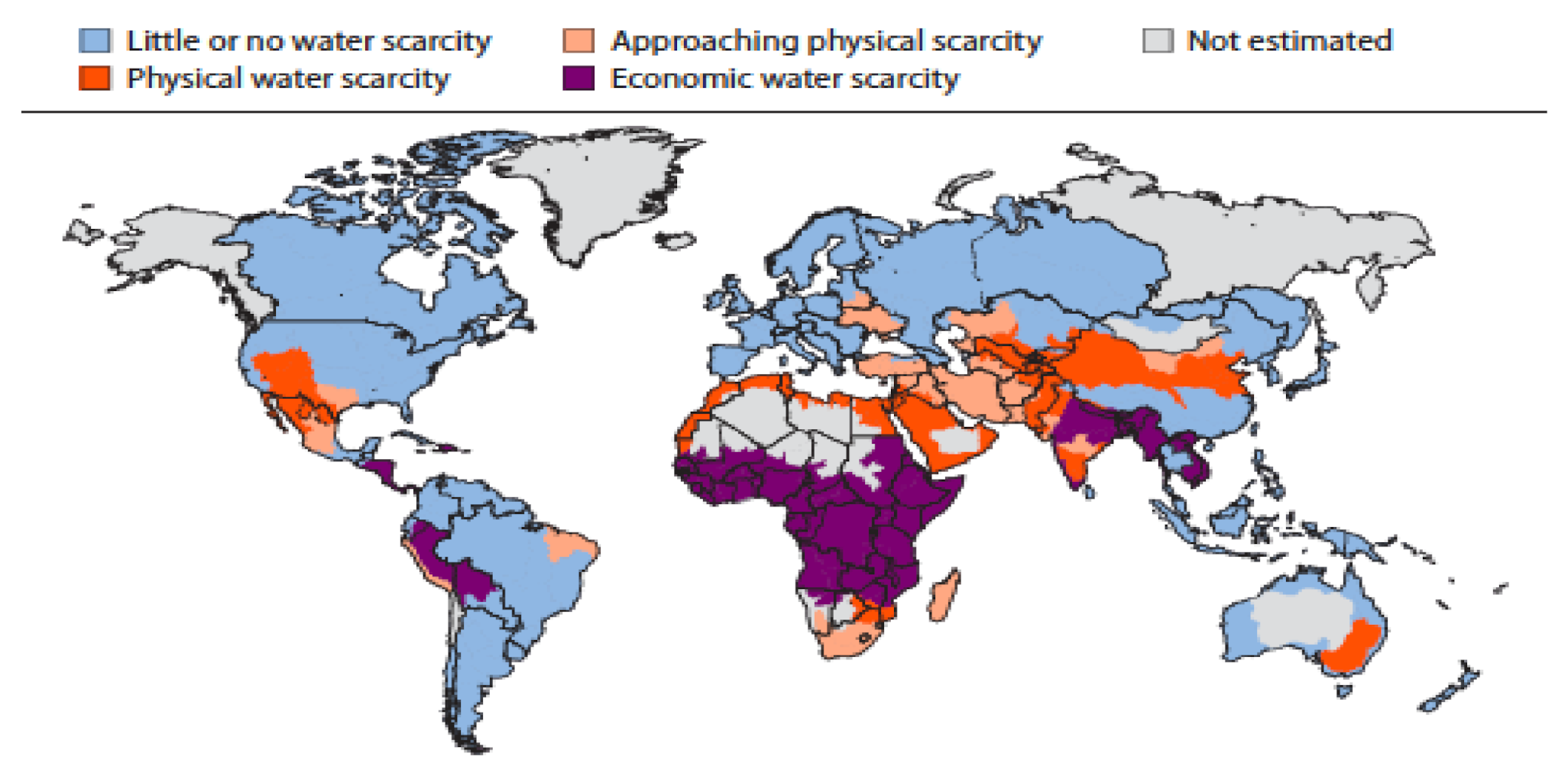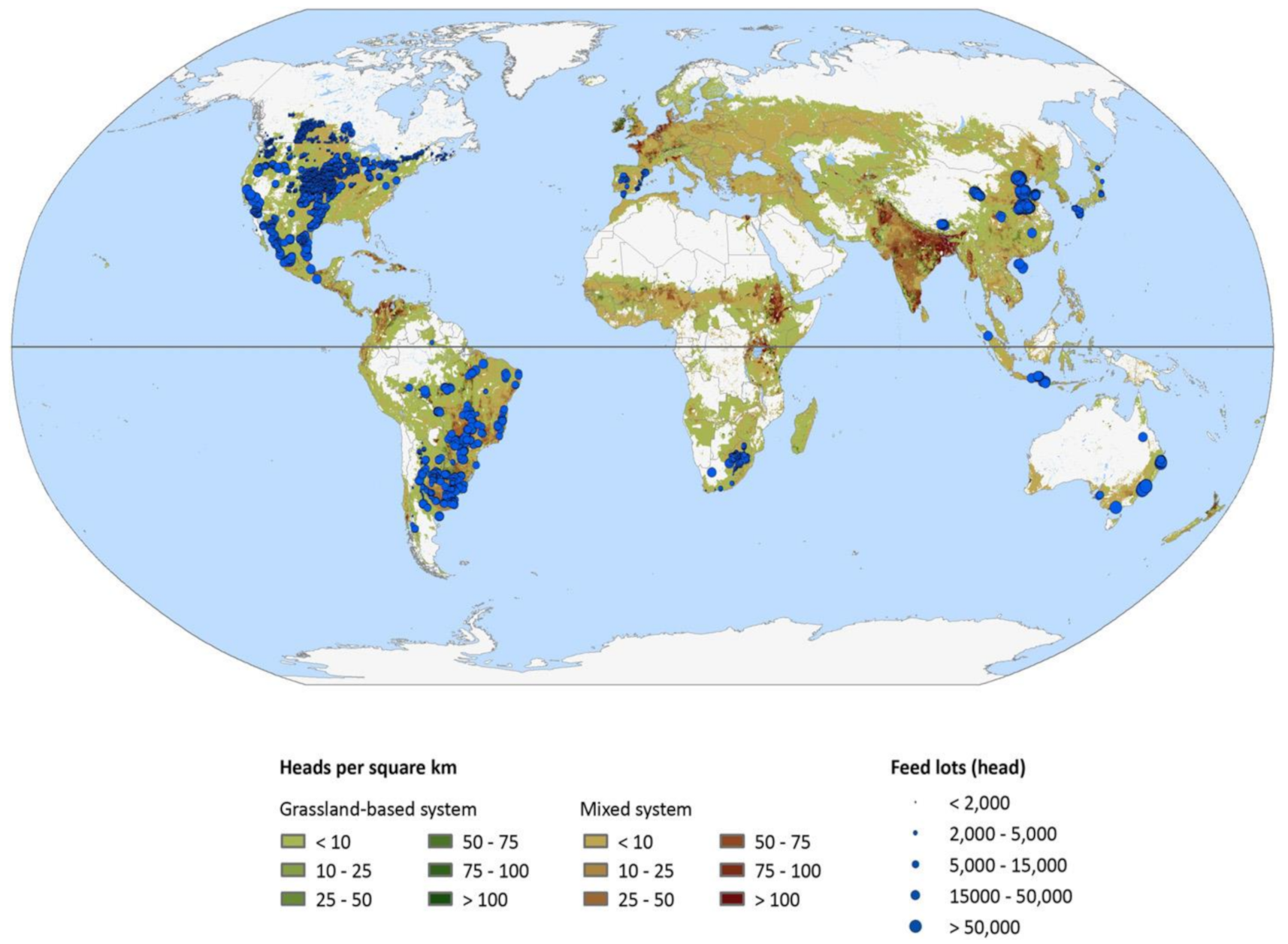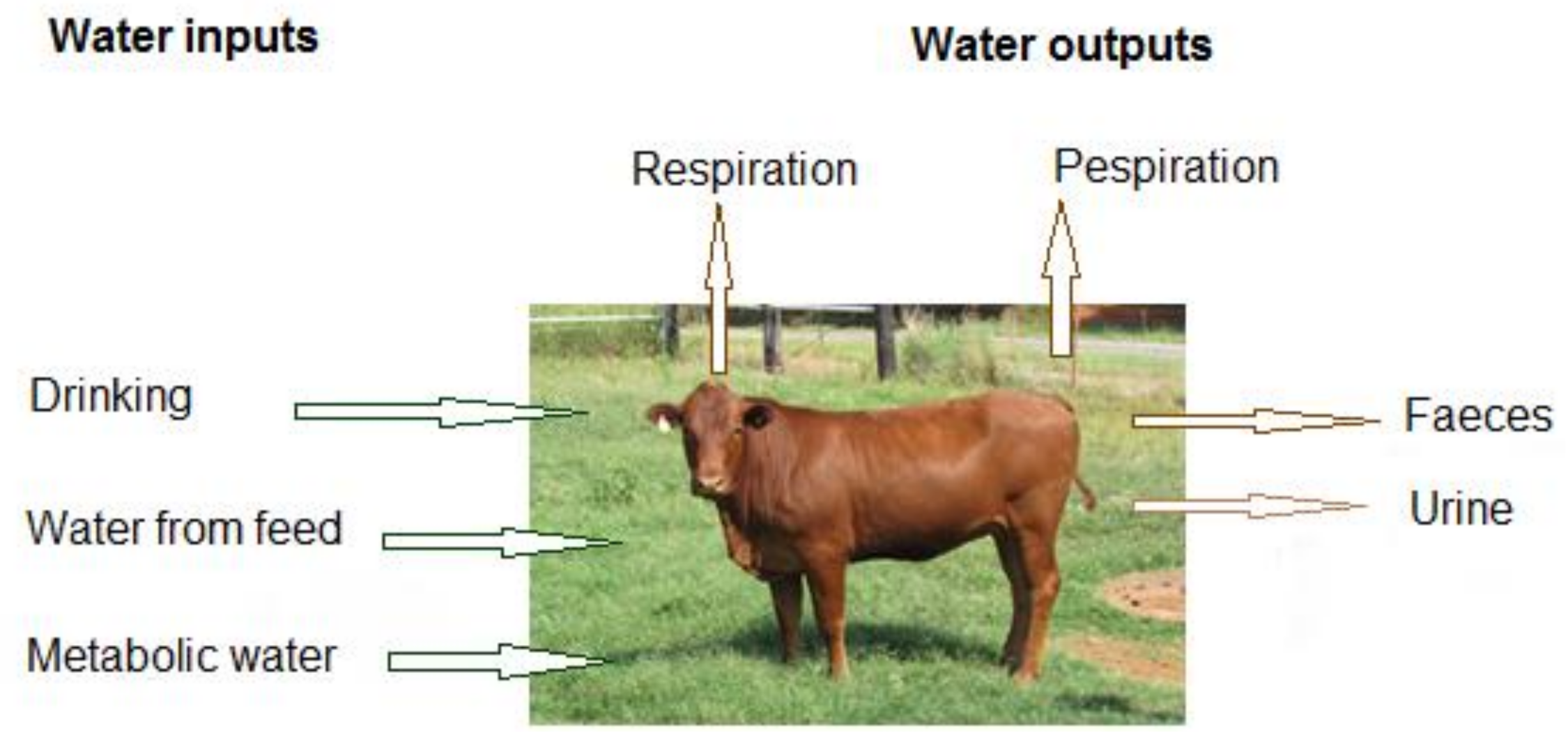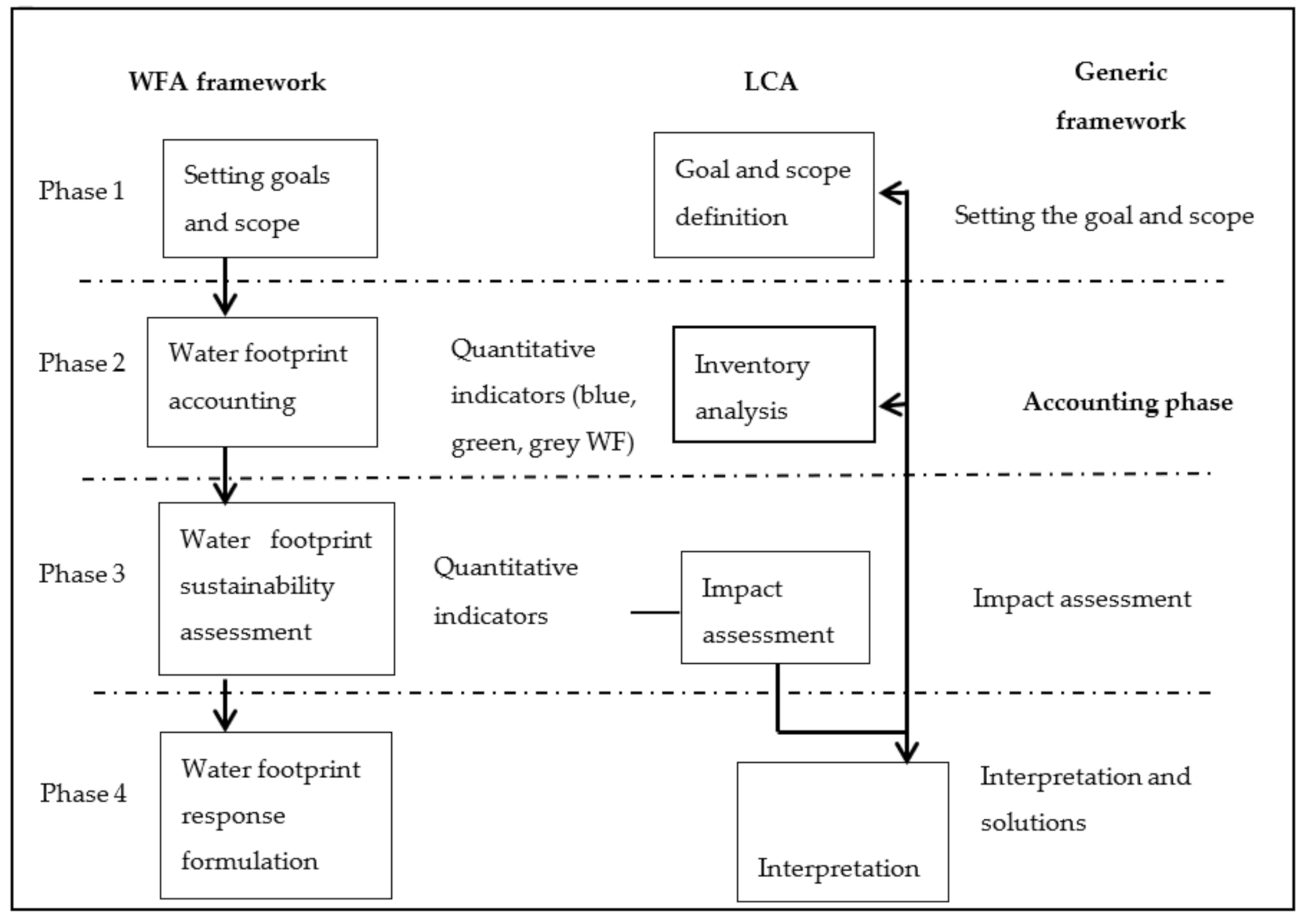Sustainable Application of Livestock Water Footprints in Different Beef Production Systems of South Africa
Abstract
1. Introduction
2. The South African Beef Industry
3. Water Footprint of Beef Production
3.1. Green Water Footprint
3.2. Blue Water Footprint
3.3. Grey Water Footprint
4. Effects of Water Footprint
4.1. Water Scarcity
4.2. Water Quality
4.3. Environmental Effects
4.4. Social Well-Being
4.5. Economic Opportunity Cost
5. Factors Affecting Water Footprint
5.1. Types of Livestock Farming Systems
5.1.1. Extensive Production System
5.1.2. Intensive Production System
5.2. Feed Composition
5.3. Feed Origin
5.4. Ambient Environment
6. Water Use Efficiency in Beef Cattle
7. Methods for Estimating Water Footprint
7.1. Water Footprint Network
7.2. Life Cycle Assessment
7.3. Net Water Footprint
8. Conclusions
Author Contributions
Funding
Conflicts of Interest
References
- Mwendera, E.; Atyosi, Y. A review of water storage for socio-economic development in South Africa. J. Water Resour. Prot. 2018, 10, 266–286. [Google Scholar] [CrossRef]
- Mpandeli, S.; Naidoo, D.; Mathaudhi, T.; Nhemachena, C.; Nhamo, L.; Liphadzi, S.; Hlahla, S.; Modi, A.T. Climate change adaptation through the water energy food nexus in Southern Africa. Int. J. Environ. Res. Public Health 2018, 15, 2306. [Google Scholar] [CrossRef] [PubMed]
- Pelletier, N.; Tyedmers, P. Forecasting potential global environmental costs of livestock production 2000–2050. Proc. Natl. Acad. Sci. USA 2010, 107, 18371–18374. [Google Scholar] [CrossRef] [PubMed]
- Sutton, M.A.; Oenema, O.; Erisman, J.W.; Leip, A.; van Grinsven, H.; Winiwarter, W. Too much of a good thing. Nature 2011, 472, 159–161. [Google Scholar] [CrossRef] [PubMed]
- Godfray, H.C.J.; Garnett, T.; Jim, W.H.; Timothy, J.K.; Lorimer, J.; Ray, T.P.; Scarborough, P.; Springmann, M.; Jebb, S.A. Meat consumption. Health Environ. Sci. 2018, 361, 5324. [Google Scholar]
- Enahoro, D.; D’Croz, D.M.; Mul, M.; Rich, K.M.; Robinson, T.P.; Thornton, P.; Staal, S.S. Supporting sustainable expansion of livestock production in South Asia and Sub-Saharan Africa: Scenario analysis of investment options. Glob. Food Secur. 2019, 20, 114–121. [Google Scholar] [CrossRef]
- Porcel, G.C.; Sanchez, D.E.; Alvarez, V.R.; Marin, R.G.; Munoz, D.M. Runoff water as a resource in the Campo de Cartagena (region of Murcia): Current possibilities for use and benefits. Water 2018, 10, 456. [Google Scholar] [CrossRef]
- Zuray, R.; Dirar, D. Farmer-led water user association in Agricultural water management. In The Oxford Handbook of Water and Society; Allan, T., Bromwich, B., Keulertz, A.C., Eds.; Oxford University Press: New York, NY, USA, 2019. [Google Scholar]
- Adduci, F.; Labella, C.; Musto, M.; D’Adamo, C.; Freschi, P.; Cosentino, C. Use of technical and economical parameters for evaluating dairy cow ration efficiency. Ital. J. Agron. 2015, 10, 202–207. [Google Scholar] [CrossRef]
- Zhao, X.; Liao, X.; Chen, B.; Tillotson, M.R.; Guo, W.; Yiping, L.I. Accounting global grey water footprint from both consumption and production perspectives. J. Clean. Prod. 2019, 225, 963–971. [Google Scholar] [CrossRef]
- Hoekstra, A.Y.; Chapagain, A.K.; Aldaya, M.M.; Mekonnen, M.M. The Water Footprint Assessment Manual: Setting the Global Standard; Routledge: London, UK, 2011. [Google Scholar]
- Chapagain, A.K.; Hoekstra, A.Y. Water Footprint of Nations; UNESCO-IHE: Delft, The Netherlands, 2004; Volume 1. [Google Scholar]
- Chapagain, A.K.; Hoekstra, A.Y. The blue, green and grey water footprint of rice from production and consumption perspectives. Ecol. Econ. 2011, 70, 749–758. [Google Scholar] [CrossRef]
- Department of Agriculture Forestry and Fisheries. A Profile of the South African Beef Market Value Chain; DAFF: Pretoria, South Africa, 2018. [Google Scholar]
- Molden, D. Water for Food, Water for Life: A Comprehensive Assessment of Water Management in Agriculture; Earthscan: London, UK, 2013. [Google Scholar]
- Zhuo, L.; Arjen, Y.H.; Wu, P.; Zhao, X. Monthly blue water footprint caps in a river basin to achieve sustainable water consumption: The role of reservoirs. Sci. Total Environ. 2019, 650, 891–899. [Google Scholar] [CrossRef] [PubMed]
- Pastor, A.V.; Ludwig, F.; Biemans, H.; Hoff, H.; Kabat, P. Accounting for environmental flow requirements in global water assessments. Hydrol. Earth Syst. Sci. 2013, 10, 14987–15032. [Google Scholar] [CrossRef]
- Reimer, J.J. On the economics of virtual water trade. J. Ecol. Econ. 2012, 75, 135–139. [Google Scholar] [CrossRef]
- Verlicchi, P.; Grillini, V. Surface water and ground water quality in South Africa and Mozambique–analysis of the most critical pollutants for drinking purposes and challenges in water treatment selection. Water 2020, 12, 305. [Google Scholar]
- Marara, T.; Paramuleni, L.G. A spatiotemporal analysis of water quality characteristics in the Klip river catchment, South Africa. Environ. Monit. Assess 2020, 192, 578. [Google Scholar] [CrossRef]
- Mekonnen, M.M.; Hoekstra, A.Y. Four billion people facing severe water scarcity. Sci. Adv. 2016, 2. [Google Scholar] [CrossRef]
- Mosase, E.; Ahiablame, L.; Srinivasan, R. Spatial and temporal distribution of blue water in the Limpopo River Basis, Southern Africa: A case study. Ecohydrol. Hygrobiol. 2019, 19, 252–265. [Google Scholar] [CrossRef]
- Kummu, M.; Ward, P.J.; de Moel, H.; Varis, O. Is physical water scarcity a new phenomenon? Global assessment of water shortage over the last two millennia. Environ. Res. Lett. 2020, 5. [Google Scholar] [CrossRef]
- Porkka, M.; Gerten, D.; Schaphoff, S.; Siebert, S.; Kummu, M. Causes and trends of water scarcity in food production. Environ. Res. Lett. 2016, 11. [Google Scholar] [CrossRef]
- Falkenmark, M.; Berntell, A.; Jagerskog, A.; Lundqvist, J.; Matz, M.; Tropp, H. On the Verge of a New Water Scarcity: A Call for Good Governance and Human Ingenuity; Stockholm International Water Institute (SIWI): Stockholm, Sweden, 2007. [Google Scholar]
- Rosa, L.; Chiarelli, D.D.; Rulli, M.C.; Dell’Angelo, J.; D’Odorico, P. Global agricultural economic water scarcity. Sci. Adv. 2020, 6. [Google Scholar] [CrossRef]
- Pahlow, M.; Snowball, J.; Fraser, G. Water footprint assessment to inform water management and policy making in South Africa. Water SA 2015, 41, 300–313. [Google Scholar] [CrossRef]
- Falkenmark, M.; Rockström, J. Balancing Water for Humans and Nature: The New Approach in Ecohydrology; Earthscan: London, UK, 2004. [Google Scholar]
- Steinfeld, H.; Gerber, P.; Wassenaar, T.; Castel, V.; Rosales, M.; de Haan, C. Livestock’s Long Shadow. Environmental Issues and Options; Food & Agriculture Organization (FAO): Rome, Italy, 2006. [Google Scholar]
- Peden, D. Looking Water and livestock for human development. In Water for Food, Water for Life: A Comprehensive Assessment of Water Management in Agriculture; Molden, D., Ed.; Earthscan: London, UK, 2007. [Google Scholar]
- Meissner, H.H.; Scholtz, M.M.; Schonfeldt, H.C. The status, socio-economic and environmental impact, and challenges of livestock agriculture in South Africa. Available online: www.rmrdsa.co.za (accessed on 15 July 2019).
- Ololade, O.O. Understanding the nexus between energy and water: A basis for human survival in South Africa. Dev. S. Afr. 2018, 35, 194–209. [Google Scholar] [CrossRef]
- Arias, R.A.; Mader, T.L. Environmental factors affecting daily water intake on cattle finished in feedlots. J. Anim. Sci. 2011, 89, 245–251. [Google Scholar] [CrossRef]
- Ahlberg, C.M.; Allwardt, K.; Broocks, A.; Bruno, K.; McPhillips, L.; Taylor, A.; Krehbiel, C.R.; Calvo-Lorenzo, M.S.; Richards, C.J.; Place, S.E.; et al. Environmental effects on water intake and water intake prediction in growing beef cattle. J. Anim. Sci. 2018, 96, 4368–4384. [Google Scholar] [CrossRef] [PubMed]
- Malan, J.C.; Flint, N.; Jackson, A.L.; Irving, A.D.; Swain, D.L. Environmental factors influencing cattle’s water consumption at offstream watering points in rangeland beef cattle. J. Liv. Sci. 2020, 231. [Google Scholar] [CrossRef]
- U.N. World Population Prospects: The 2012 Revision. Dept. Economic and Social Affairs, Population Division, Population Estimates and Projections Section. 2015. Available online: http://esa.un.org/wpp/. (accessed on 26 July 2019).
- Sartori, M.; Tarvenini, S.; Consalvo, C. Water Footprint of Italy; Alessi, E., Imperatrice, M., Eds.; WWF: Rome, Italy, 2014. [Google Scholar]
- Le Roux, B.; van der Laan, M.; Vahrmeijer, T.; Annandale, J.G.; Keith, L.; Bristow, K.L. Water Footprints of Vegetable Crop Wastage along the Supply Chain in Gauteng, South Africa. Water 2018, 10, 539. [Google Scholar] [CrossRef]
- Chouchane, H.; Hoekstra, A.Y.; Krol, M.S.; Mekonnen, M.M. The water footprint of Tunisia from an economic perspective. Ecol. Indic. 2015, 52, 311–319. [Google Scholar] [CrossRef]
- Owusu-Sekyere, E.; Scheepers, M.E.; Jordaan, H. Economic water productivities along the dairy value chain in South Africa: Implications for sustainable and economically efficient water-use policies in the dairy industry. J. Ecol. Econ. 2017, 134, 22–28. [Google Scholar] [CrossRef]
- Lardy, G.; Stoltenhow, C.; Johnson, R. Livestock and Water; North Dakota State University: Fargo, ND, USA, 2008. [Google Scholar]
- Deutsch, L.; Falkenmark, M.; Gordon, L.; Rockström, J.; Folke, C. Water-mediated ecological consequences of intensification and expansion of livestock production. In Livestock in a Changing Landscape; Steinfeld, H., Mooney, H.A., Schneider, F., Neville, L.E., Eds.; Island Press: Washington, DC, USA, 2010; pp. 97–111. [Google Scholar]
- Du Toit, C.J.L.; Meissner, H.H.; van Niekerk, W.A. Direct methane and nitrous oxide emissions of South African dairy and beef cattle. S. Afr. J. Anim. Sci. 2013, 43, 320–339. [Google Scholar] [CrossRef]
- Scholtz, M.M.; van Ryssen, J.B.J.; Meissner, H.H.; Laker, M.C. South African perspective on livestock production in relation to greenhouse gasses and water usage. S. Afr. J. Anim. Sci. 2013, 43, 247–254. [Google Scholar] [CrossRef]
- SIWI; IFRI; IUCN; IWMI. Let it Reign: The New Water Paradigm for Global Food Security; Final Report to CSD-13; Stockholm International Water Institute: Stockholm, Sweden, 2005. [Google Scholar]
- Falkenmark, M.; Rockström, J. The New Blue and Green Water Paradigm: Breaking New Ground for Water Resources Planning and Management. J. Water Resour. Plan. Manag. 2006, 129–132. [Google Scholar] [CrossRef]
- Gerber, P.J.; Hristov, A.N.; Henderson, B.; Makkar, H.; Oh, J.; Lee, J.C.; Meinen, R.; Montes, F.; Ott, T.; Firkins, J.; et al. Technical options for the mitigation of direct methane and nitrous oxide emissions from livestock: A review. Animals 2013, 7, 220–234. [Google Scholar] [CrossRef]
- Capper, J.L.; Cady, R.A.; Bauman, D.E. The effects of improved performance in the U.S. dairy cattle industry on environmental impacts between 2007 and 2017. J. Anim. Sci. 2020, 98, 1–14. [Google Scholar] [CrossRef] [PubMed]
- Vasconcelos, J.T.; Tedeschi, L.O.; Fox, D.G.; Galyean, M.L.; Greene, L.W. Feeding nitrogen and phosphorus in beef cattle feedlot production to mitigate environmental impacts. Prof. Anim. Sci. 2007, 23, 8–17. [Google Scholar] [CrossRef]
- Marẻ, F.A.; Jordaan, H. Industrially finished calves: A water footprint profitability paradox. Water 2013, 11, 2565. [Google Scholar] [CrossRef]
- Zimmer, D.; Renault, D. Virtual water in food production and global trade: Review of methodological issues and preliminary results. In Virtual Water Trade. Proceedings of the International Expert Meeting on Virtual Water Trade. Value of Water Research Report12, IHE Delft, The Netherlands, 12–13 December 2002; Hoekstra, A.Y., Ed.; IHE: Delft, The Netherlands, 2003; pp. 93–109. [Google Scholar]
- Pimentel, D. Techniques for Reducing Pesticides: Environmental and Economic Benefits; John Wiley: Hoboken, NJ, USA, 1997. [Google Scholar]
- Pimentel, D. Livestock Production and Energy Use. In Encyclopedia of Energy; Matsumura, R., Ed.; Elsevier: Amsterdam, The Netherlands, 2004; pp. 671–676. [Google Scholar]
- Silanikove, N. Effect of heat stress on the welfare of extensively managed domestic ruminants. J. Livest. Prod. Sci. 2000, 67, 1–18. [Google Scholar] [CrossRef]
- Khelil-Arfa, H.; Boudon, A.; Maxin, G.; Faverdin, P. Prediction of water intake and excretion flows in Holstein dairy cows under thermoneutral conditions. Animals 2012, 6, 1662–1676. [Google Scholar] [CrossRef]
- Meyer, U.; Stahl, W.; Flachowsky, G. Investigations on the water intake of growing bulls. J. Livest. Sci. 2006, 103, 186–191. [Google Scholar] [CrossRef]
- NRC. Nutrient Requirement of Beef Cattle, 7th Revised ed.; National Academy Press: Washington, DC, USA, 2000. [Google Scholar]
- Cosentino, C.; Adduci, F.; Musto, M.; Paolino, R.; Freschi, P.; Pecora, G.; D’Adamo, C.; Valentini, V. Low vs high “water footprint assessment” diet in milk production: A comparison between triticale and corn silage based diets. Emir. J. Food Agric. 2015, 27, 312–317. [Google Scholar] [CrossRef]
- Atzori, A.S.; Canalis, C.; Fransesconi, A.H.D.; Pulina, G. A preliminary study on a new approach to estimate water resource allocation: The net water footprint applied to animal products. Agric. Agric. Sci. Procedia 2016, 8, 50–57. [Google Scholar] [CrossRef]
- Vanham, D.; Bidoglio, G. A review on the indicator water footprint for the EU28. Ecol. Indic. 2013, 26, 61–75. [Google Scholar] [CrossRef]
- Boulay, A.; Hoekstra, A.Y.; Vionnet, S. Complementaries of water-focused Life Cycle Assessment and Water Footprint Assessment. Environ. Sci. Technol. 2013, 47, 11926–11927. [Google Scholar] [CrossRef] [PubMed]
- Pacetti, T.; Lombardi, L.; Federici, G. Water-energy Nexus: A case of biogas production from energy crops evaluated by Water Footprint and Life Cycle Assessment (LCA). J. Clean. Product. 2015, 101, 278–291. [Google Scholar] [CrossRef]




| Feedstuff | Marginal Water Productivities (Kg/m3) | % Contribution to Milk Yield | Value Added (Rand/Kg) | Economic Water Productivities (Rand/m3) |
|---|---|---|---|---|
| Lucerne hay | 3.64 | 16.04 | 1.88 | 6.84 |
| Oats silage | 3.84 | 3.99 | 1.37 | 5.22 |
| Sorghum silage | 5.22 | 9.80 | 1.67 | 8.72 |
| Maize silage | 4.91 | 14.78 | 1.66 | 3.25 |
| Maize meal | 1.53 | 28.42 | 4.39 | 6.71 |
| HPC | 0.93 | 18.47 | 6.91 | 6.43 |
| River basin | Population | Number of Months per Year that A Basin Faces Blue-Water Scarcity | Products with A Significant Contribution (≥3%) to WFblue in the Basin | ||
|---|---|---|---|---|---|
| Moderate | Significant | Severe | (% contribution) | ||
| Limpopo | 15,637,400 | 2 | 0 | 5 | Fodder crops—31%, sugarcane—11%, seed cotton—11%, wheat—6%, domestic—5%, maize—4%, bananas—3% |
| Orange | 12,665,700 | 2 | 1 | 3 | Fodder crops—36%, wheat—11%, maize—8%, sugarcane —7%, domestic—5%, potatoes—3%, grapes—3% |
| Komati | 2,416,140 | 1 | 0 | 3 | Sugarcane—33%, fodder crops—28%, maize—5%, domestic—5%, seed cotton—4%, apples—4%, bananas—3% |
| Maputo | 1,264,770 | 1 | 0 | 3 | Sugarcane—81%, fodder crops—6%, domestic—4% |
| Tugela | 1,784,420 | 2 | 0 | 3 | Fodder crops—28%, maize—16%, grapes—12%, sugarcane—6%, apple—5%, wheat—4%, bananas—4%, domestic—4%, pears—3% |
| Great Fish | 299,461 | 0 | 0 | 12 | Fodder crops—49%, sugarcane—10%, apples—6%, bananas—5%, maize—3%, pears—3% |
| Doring | 167,084 | 0 | 1 | 7 | Fodder crops—48%, wheat—11%, sugarcane—11%, grapes—11%, potatoes—3% |
| Gamka | 278,648 | 2 | 1 | 1 | Fodder crops—62%, sugarcane—10%, grapes—7%, wheat—6% |
| Great Kei | 873,587 | 0 | 1 | 11 | Fodder crops—53%, domestic—10%, sugarcane—9%, apples—4%, bananas—3% |
| Mean | S.D. | Min | Max | r | |
|---|---|---|---|---|---|
| Average ambient temperature (°C) | 11.2 | 6.9 | −8.6 | 26.0 | 0.295 * |
| Maximum ambient temperature (°C) | 15.0 | 8.1 | −5.9 | 33.8 | 0.282 * |
| Relative humidity (%) | 79.8 | 11.9 | 48.0 | 100.0 | −0.092 * |
| Water intake (kg/day) | 17.8 | 6.7 | 0 | 78.7 |
Publisher’s Note: MDPI stays neutral with regard to jurisdictional claims in published maps and institutional affiliations. |
© 2020 by the authors. Licensee MDPI, Basel, Switzerland. This article is an open access article distributed under the terms and conditions of the Creative Commons Attribution (CC BY) license (http://creativecommons.org/licenses/by/4.0/).
Share and Cite
Ngxumeshe, A.M.; Ratsaka, M.; Mtileni, B.; Nephawe, K. Sustainable Application of Livestock Water Footprints in Different Beef Production Systems of South Africa. Sustainability 2020, 12, 9921. https://doi.org/10.3390/su12239921
Ngxumeshe AM, Ratsaka M, Mtileni B, Nephawe K. Sustainable Application of Livestock Water Footprints in Different Beef Production Systems of South Africa. Sustainability. 2020; 12(23):9921. https://doi.org/10.3390/su12239921
Chicago/Turabian StyleNgxumeshe, Ayanda M., Motshekwe Ratsaka, Bohani Mtileni, and Khathutshelo Nephawe. 2020. "Sustainable Application of Livestock Water Footprints in Different Beef Production Systems of South Africa" Sustainability 12, no. 23: 9921. https://doi.org/10.3390/su12239921
APA StyleNgxumeshe, A. M., Ratsaka, M., Mtileni, B., & Nephawe, K. (2020). Sustainable Application of Livestock Water Footprints in Different Beef Production Systems of South Africa. Sustainability, 12(23), 9921. https://doi.org/10.3390/su12239921







